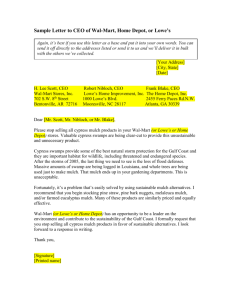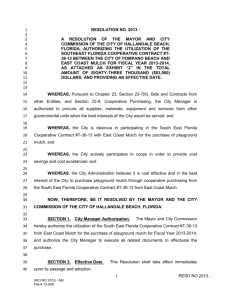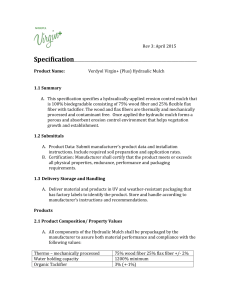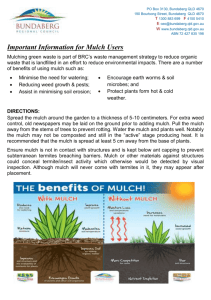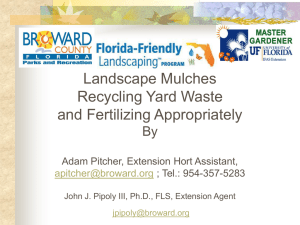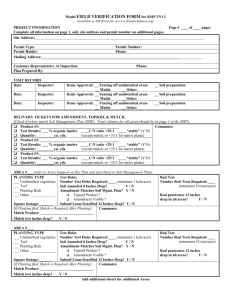Read Full Report
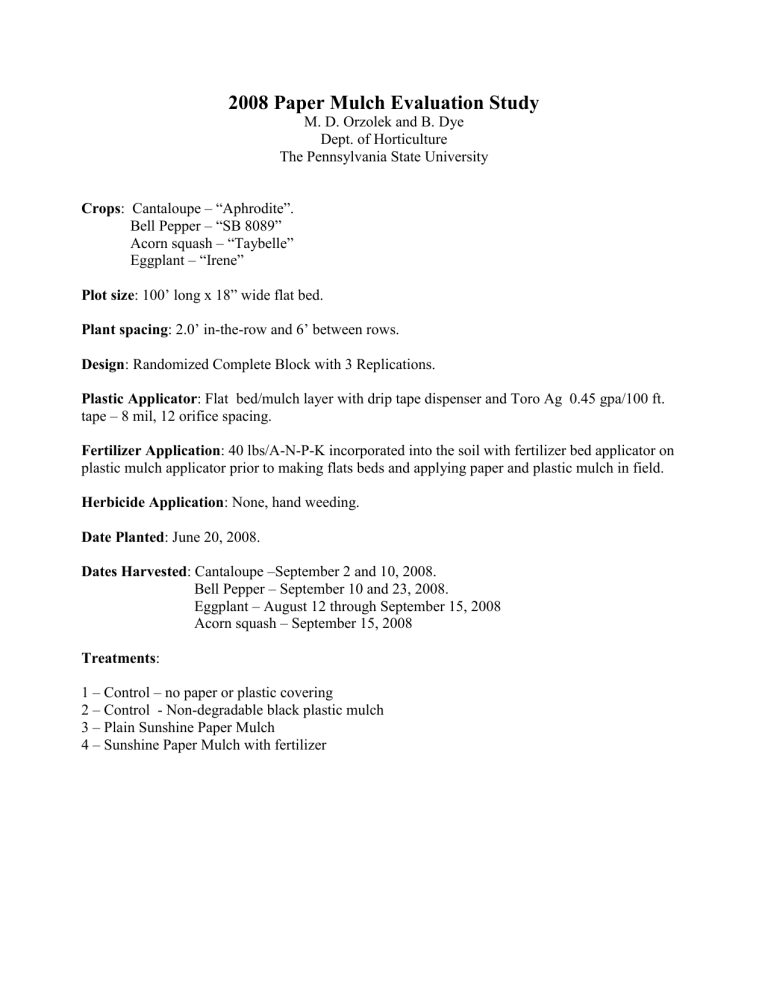
2008 Paper Mulch Evaluation Study
M. D. Orzolek and B. Dye
Dept. of Horticulture
The Pennsylvania State University
Crops : Cantaloupe – “Aphrodite”.
Bell Pepper – “SB 8089”
Acorn squash – “Taybelle”
Eggplant – “Irene”
Plot size : 100’ long x 18” wide flat bed.
Plant spacing : 2.0’ in-the-row and 6’ between rows.
Design : Randomized Complete Block with 3 Replications.
Plastic Applicator : Flat bed/mulch layer with drip tape dispenser and Toro Ag 0.45 gpa/100 ft. tape – 8 mil, 12 orifice spacing.
Fertilizer Application : 40 lbs/A-N-P-K incorporated into the soil with fertilizer bed applicator on plastic mulch applicator prior to making flats beds and applying paper and plastic mulch in field.
Herbicide Application : None, hand weeding.
Date Planted : June 20, 2008.
Dates Harvested : Cantaloupe –September 2 and 10, 2008.
Bell Pepper – September 10 and 23, 2008.
Eggplant – August 12 through September 15, 2008
Acorn squash – September 15, 2008
Treatments :
1 – Control – no paper or plastic covering
2 – Control - Non-degradable black plastic mulch
3 – Plain Sunshine Paper Mulch
4 – Sunshine Paper Mulch with fertilizer
Table 1. The marketable fruit yield of cantaloupe (cv. Aphrodite) from plants grown on soil, nondegradable plastic mulch and paper with and without fertilizer at the Horticulture Research Farm,
Rock Springs, PA.2008.
_______________________________________________________________________________
Marketable Fruit Yield
Mulch type No. of fruit Wt. of fruit
(lbs.)
Avg. fruit
Wt. (lbs)
Control - soil 9.3
Control – ND mulch 8.7
Paper - plain
Paper - fertilizer
9.0
11.3
27.6
36.5
36.0
42.6
3.0
4.2
4.0
3.8
SE 0.53
3.1
________________________________________________________________________________
ND – Non degradable plastic mulch
Table 2. The marketable fruit yield of bell pepper (cv. Aristotle) from plants grown on soil, nondegradable plastic mulch and paper with and without fertilizer at the Horticulture Research Farm,
Rock Springs, PA.2008.
_______________________________________________________________________________
Mulch type
Marketable Fruit Yield
No. of fruit Wt. of fruit
(lbs.)
Avg. fruit
Wt. (oz.)
Control - soil 16.0
Control – ND mulch 38.0
Paper - plain
Paper - fertilizer
21.3
18.3.
4.7
18.5
6.6
7.6
4.7
7.8
4.9
6.7
SE 4.5
3.0
________________________________________________________________________________
ND – Non degradable plastic mulch
Table 3. The marketable fruit yield of eggplant (cv. Irene) from plants grown on soil, nondegradable plastic mulch and paper with and without fertilizer at the Horticulture Research Farm,
Rock Springs, PA.2008.
_______________________________________________________________________________
Marketable Fruit Yield
Mulch type No. of fruit Wt. of fruit
(lbs.)
Avg. fruit
Wt. (oz.)
Control - soil 9.0
Control – ND mulch 34.7
Paper - plain 14.3
5.1
28.1
10.4
16.0
4.9
9.1
13.0
11.7
12.0 Paper - fertilizer
SE
21.3
5.6
________________________________________________________________________________
ND – Non degradable plastic mulch
Table 4. The marketable fruit yield of acorn squash (cv. Taybelle) from plants grown on soil, nondegradable plastic mulch and paper with and without fertilizer at the Horticulture Research Farm,
Rock Springs, PA.2008.
_______________________________________________________________________________
Marketable Fruit Yield
Mulch type No. of fruit Wt. of fruit
(lbs.)
Avg. fruit
Wt. (lbs)
Control - soil 11.7
Control – ND mulch 12.0
Paper - plain
Paper - fertilizer
13.0
16.0
25.7
23.6
27.5
34.1
2.2
2.0
2.1
2.1
SE 1.0 2.3
________________________________________________________________________________
ND – Non degradable plastic mulch
Comments:
The paper mulch was applied in the field with small flat bed mulch layer (4 ft. wide rolls) and drip tape dispenser with minimum problems. When the press wheels on the mulch layer were angled, the paper mulch tore from the pressure exerted on the paper by the pres wheel. If the press wheels were perfectly parallel to the row direction, the paper did not tear. After a rain, the paper dried and remained intact. It was not difficult to make a hole in the paper mulch every 2 feet to place a transplant in the soil. Observations made on July 14, 2008 included the following: plain (nonfertilizer) paper degraded quicker than the fertilizer added to paper product. The plain paper ripped in large pieces, but remained on site. Visible growth difference in plants growing on plain paper
compared to bare ground. Growth of plants comparable on paper mulches compared to nondegradable black plastic mulch. The paper mulches inhibited growth of weeds in the row. Soil temperature 2 inches beneath the soil surface on July 14 were: bare ground – 84°F, plain paper –
84°F, paper with 5-5-5 – 82.3°F, and non-degradable plastic mulch – 97.4°F.
There was no difference in the yield of marketable cantaloupe harvested from plants growing on either bare ground, plastic or paper mulch (Table 1). Ironically, the highest yield was harvested from plants grown on the paper mulch that had the 5-5-5 incorporated into the paper. Interestingly, similar average fruit weight was harvested from plants grown on either the paper or plastic mulches, but 25% smaller fruit from plants grown on the bare ground
Pepper plants that were grown on the non-degradable black plastic mulch produced higher marketable pepper fruit yields compared to the other treatments (Table 2). Pepper plants growing on bare ground produced fruit with the lowest average fruit weight and plants growing on the nondegradable plastic mulch produced fruit with the highest average fruit weight. ). Pepper plants growing on paper mulch with 5-5-5 incorporated into the paper produced fruit with an intermediate average fruit compared to bare ground and plastic mulch.
Because eggplants grow best under high temperatures (air and soil), the highest marketable yield of eggplant was harvested from plants growing on the non-degradable plastic mulch (Table 3). It was interesting to note however, that plants grown on the paper mulch with 5-5-5 produced 50% more eggplant compared to plants grown on the plain paper.
The highest yield of acorn squash was harvested from plants grown on the paper mulch with 5-5-5 and was 36% more fruit compared to the bare ground treatment (Table 4). Surprisingly, plants growing on the non-degradable plastic mulch produced the fewest fruits per treatment compared to the paper and bare ground. It was noted that several acorn squash fruit appeared sunburned when grown on the plastic mulch.
After harvesting the crop in October, the non-degradable mulch film was retrieved from the field along with the drip tape. However, the paper mulches were rototilled into the soil and the soil will be checked in the spring of 2009 for any paper mulch residue.
Conclusions:
1 - Based on the crop yield of cantaloupe, eggplant and acorn squash, the paper mulch (especially with the 5-5-5 incorporated into the paper mulch itself) performed as effectively as the nondegradable mulch films in 2008.
2 –When the paper mulch degraded before the vegetable crops growing on the mulch matured, weed competition was not a problem and did not affect either the yield or quality of the harvested crop.
3 – After harvesting the crop growing on the paper mulch, simply incorporating the remaining paper mulch into the soil by rototilling will enhance degradation of the paper mulch.

